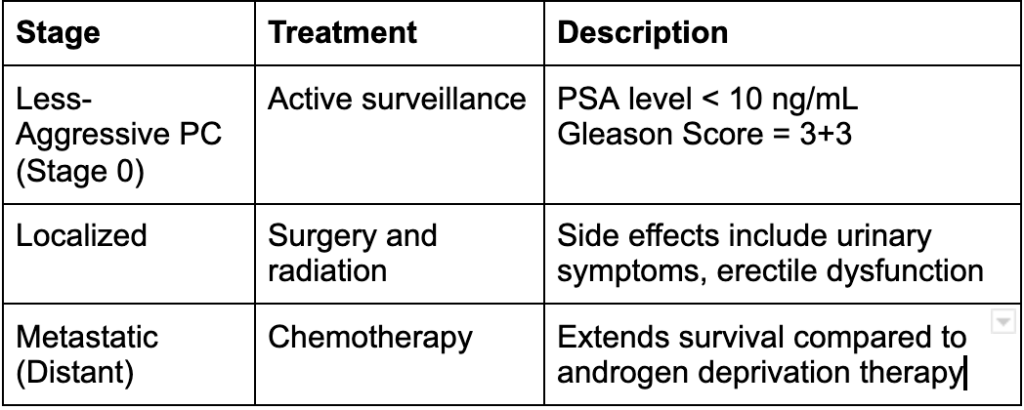Introduction
According to the International Agency for Research on Cancer, in 2018, there were 18.1 million new cancer cases and 9.5 million deaths worldwide. By 2040, it is estimated that these numbers will rise to 29.5 million and 16.4 million, respectively.
Each year, 1.4 million people are diagnosed with prostate cancer (PC) and over 350,000 die from the disease. PC is one of the most common forms of cancer, and other than melanoma (skin cancer), is the most prevalent cancer in American men.
Cancer affects more men than women. This month we bring awareness to men’s health issues.
What is prostate cancer?
In order to understand PC, it is important to understand the anatomy, function and location of the prostate gland. The prostate is a walnut-sized gland in the male reproductive system, situated below the bladder. It weighs roughly 20 grams and is 3 cm long. As men age, the prostate undergoes two growth periods—one is in early puberty when it doubles in size; the second phase begins at age 25, after which it continues to grow for the remainder of a man’s life. An enlarged prostate (called benign prostatic hyperplasia) is not to be confused with PC.
Androgens are male sex hormones that maintain masculine characteristics in reproductive tissues. Testosterone and dihydrotestosterone (also called DHT) are the primary androgens in male mammals. The prostate requires androgens to function optimally. It secretes one-third of seminal fluids, which nourish, protect and transport sperm (the remaining two-thirds comes from the seminal vesicles). Additionally, the prostate secretes prostate-specific antigen (PSA), a protein that helps semen retain its liquid state. High PSA levels in the blood are a potential indicator of PC risk.
Prostatic intraepithelial neoplasia (PIN) is one of the potential signs of PC. In this condition, glandular cells within the prostate appear abnormal. Based on the abnormality of the appearance of the cells, PIN is classified as either low-grade PIN or high-grade PIN. Low-grade PIN is characterised by almost-normal prostate cell patterns, while high-grade PIN reveals the abnormal appearance of prostate cells. The PIN can appear in males as young as 20, and almost half of all men have PIN by the time they reach the age of 50. Low-grade PIN is not considered threatening—many men may have PIN without any incidence of PC. However, the high-grade PIN is viewed as a precursor to PC.
PC begins when mutations occur in normal prostate gland cells. These cancerous cells begin to grow and accumulate to form a tumour. The majority of PC are adenocarcinomas—malignant tumours formed from gland cells within the prostate. Other types of PC include small cell carcinomas, neuroendocrine tumours, transitional cell carcinomas and sarcomas. Incidences of these types of PC are extremely rare.
The development of PC can be categorized into the following four stages:
· Stage 0: Presence of precancerous cells; slow-growing and concentrated in a small area
· Localized: Cancer present only in the prostate gland
· Regional: Cancer spreads to surrounding tissues
· Distant: Cancer metastasizes to other parts of the body
Unfortunately, there are no symptoms of early-stage PC. Advanced symptoms of PC often overlap with other conditions such as a urinary tract infection (UTI). They include:
· Trouble urinating
· Decreased force in the urine stream
· Frequent urge to urinate (especially at night)
· Blood in urine/semen
· Pain in the bones
· Weight loss
· Erectile dysfunction
Consequently, there is an increased chance of PC going undetected if one isn’t screened and tested properly.
Diagnosis
Early detection of PC gives patients a high chance of living longer. Screening is recommended for men above the age of 50. However, at-risk population screening can begin as early as age 40.
Risk factors
PC is particularly common in developed countries. The following demographics are predisposed to a higher risk of PC:
· Old age: The risk of PC increases with age, generally after age 50. About 60 percent of PC cases are diagnosed in men aged 65 years or older.
· Race: PC is more common in black males than white males. Asians and Hispanics have an inherently lower risk than both.
· Family history: Close relatives with a history of PC increases the likelihood that one will also develop PC.
· Obese: Obesity is linked to PC. Studies reveal that a 5 kg/m2 increase in BMI was associated with a 20 per cent higher risk of death from PC.
Treatment
Treatment of PC depends on the stage the patient finds themselves in:

Five things to learn about prostate cancer
PC doesn’t exclusively affect men
Although PC has been studied extensively in the male population (meaning, people who are assigned male at birth and identify as male), anyone with a prostate can develop PC. Trans women and non-binary people who are assigned male at birth as well as some intersex people have a prostate. During genital reconstructive surgery, the prostate is not removed and exposes the patient to a potential risk of PC.
Androgens promote normal prostate maturity, but they also influence the development and progression of PC. When trans women undergo hormone therapy, testosterone is suppressed by the removal of the testicles, testosterone blockers or feminizing hormones such as oestrogen. Thus, a reduction in testosterone is associated with a reduced risk of PC.
A Dutch study revealed that trans women receiving androgen deprivation therapy and oestrogens were less likely to develop PC. However, studies also reveal that oestrogen may influence malignant tumour progression due to increased expression of enzymes for oestrogen metabolism.
PC has a high survival rate
A 5-year relative survival rate compares the outlook of cancer patients to the general population. A 70 per cent 5-year survival rate indicates that patients with cancer are 70 per cent as likely as people who do not have cancer to live at least five years after diagnosis. The Surveillance, Epidemiology and End Result Program collects statistics of cancer incidence and mortality. They define only three stages of PC—localized, regional and distant. The 5-year survival rate for both localized and regional PC is nearly 100 per cent (97.5 per cent overall). However, when PC is distant, i.e. the cancer has metastasized to other parts of the body, the 5-year survival rate drops to 30 per cent This illustrates the importance of the early detection of PC, as the condition can be managed with a low risk of mortality.
Young people can develop PC
An increase in PSA screening has led to the detection of early-onset PC. Early-onset PC is diagnosed in patients aged 55 or younger and is considered a different clinical condition from PC at an older age. Survival rates are poor for patients with early-onset PC as compared to older patients. Patients that exhibit high Gleason scores in the 35–44 age group have higher mortality rates as compared to PC patients in the 64–74 category. Patients with early-onset PC are more likely to exhibit a greater number of genetic variants, associated with a higher risk of PC. A combination study detailing the prevalence of early-onset PC across the globe revealed that the incidence of PC in men aged less than 40 years has increased steadily by around 2 per cent per year from 1990 to 2017.
Blood glucose’s link to PC
Fasting blood glucose (FBG) is a measure of a person’s serum glucose level after an overnight fast. An FBG level of lower than 99 mg/dL is considered normal, 100–125 mg/dL is classified as prediabetes, while anything above 126+ mg/dL indicates that the patient has diabetes.
Higher FBG levels are associated with a lower risk of PC; however, patients with a diabetic glucose level may have an increased risk of PC development. Dickerman et al. investigated the link between type 2 diabetes and PC and found that men with diabetes exhibit an increased risk of total and aggressive PC as compared to men with normal fasting blood glucose. Patients with aggressive PC demonstrate impaired glucose tolerance as compared to men with similar traits (in terms of age and body). Left untreated, diabetic fasting blood glucose levels may be a PC risk factor.
Hyperglycemia occurs when blood glucose levels exceed 125 mg/dL. It is the result of reduced insulin secretion, decreased glucose utilization and increased glucose production. Several studies document the link between hyperglycemia and PC—identifying the former as an inherent risk factor in the progression of the disease. According to Johns Hopkins Medicine, the chances of dying from PC increase fivefold in hyperglycemic patients.
Metabolic syndrome refers to a group of conditions that simultaneously occur, elevating your risk of heart disease, stroke and type 2 diabetes. These conditions include increased blood pressure, high blood sugar, excess body fat around the waist and abnormal cholesterol or triglyceride levels. A study by Kheterpal et al. reveals that patients with metabolic syndrome were found with higher Gleason scores than those without, indicating the presence of more aggressive PC. A Finnish study concluded that middle-aged men with metabolic syndrome were more likely to develop PC.
Lifestyle changes improve chances of managing PC
Old age, race and family history of PC are risk factors beyond an individual’s control. However, people can exercise some degree of control over their lifestyle choices. The World Cancer Research Fund released a list of eight lifestyle recommendations to reduce the risk of aggressive PC. Men who adhered to four or fewer recommendations ran a higher risk of developing aggressive tumours. In order to maintain a healthy lifestyle and ward off potential cancer, individuals are encouraged to:
- Eat a variety of plant-based foods—fruits, vegetables, grains and legumes
- Stay physically active
- Maintain a healthy weight
- Limit alcohol and tobacco consumption
Conclusion
Cancer occurs due to a breakdown in ordinary cellular processes and remains a leading cause of death across the globe. PC is a high-incidence disease, especially in older men. It occurs when abnormal cells in the prostate grow exponentially, forming a tumour. There are various stages of PC—but the disease is highly manageable and chances of survival are extremely high if detected in its early stages. Populations at risk of PC include black males and individuals who have a family history of the disease. However, men are not the only ones who can contract PC. Any individual with a prostate, such as a transgender woman, can contract it. PC is also not confined to older people; in fact, in younger men, it is more lethal. Obesity has been linked to diabetes, cardiovascular disease and PC; however, one can make various lifestyle improvements, such as inculcating a plant-based diet and exercising regularly to reduce the likelihood of aggressive PC. Individuals must also pay heed to their blood glucose levels, as this is associated with a higher risk of PC.
Disclaimer:The contents of this article are for general information and educational purposes only. It neither provides any medical advice nor intends to substitute professional medical opinion on the treatment, diagnosis, prevention or alleviation of any disease, disorder or disability. Always consult with your doctor or qualified healthcare professional about your health condition and/or concerns and before undertaking a new healthcare regimen including making any dietary or lifestyle changes.
References
- https://www.cancer.gov/about-cancer/understanding/what-is-cancer#cell-differences
- https://www.cancer.gov/about-cancer/understanding/statistics
- https://www.who.int/news-room/fact-sheets/detail/cancer
- https://www.harvardmagazine.com/2017/03/why-is-cancer-more-common-in-men
- https://www.healthgrades.com/right-care/prostate-cancer/10-surprising-facts-about-prostate-cancer







